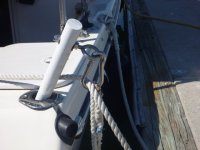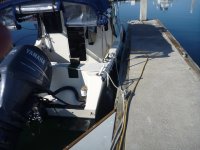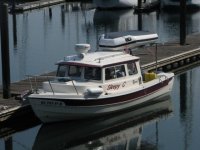We use 6 1/2 x 22, Taylor "super fenders". We hand them off the mid ships cleat (by the forward window on the pilot house), the hand hold by the cockpit, aft bulkhead of the cabin, and aft cleat. We use smaller lines on the fender--1/4" x 6 feet. We put an eye spice in one end, and take the eye thru the fender eye, then double back and pass the end of the fender line thru the loop. This leaves about 5' line for tying the fender off. If we rarely need a second line to hang the fender horizontal, we have several extra 1/4" lines handy.
We take the double braid 3/8" mooring lines (mostly 15 feet, and color coded--red, blue, black, gold and white) with an eye splice thru the cleat, then doubling back over the horns of the cleat. Next we put the fender on top of this line--if we want to bring the mooring line back to the boat, there is still plenty of room on the cleat for the dock line to be cleated on the boat.
On our fishing boat (18 foot Caracal) we use a PVC pipe such as Wil-C uses, and it is a great idea where you have fishing rod holders.
I have never used fender clips on all of the boats I have owned--either a cleat, stanchion post, turnbuckle (sail) or hand rail to tied the fender too.
One thing to remember that you have to store fenders. We have several inflatable large fenders, and a pump, if we need a 36" fender--and if we are going to be tying up to pilings or concrete cay, we use a fender board.



